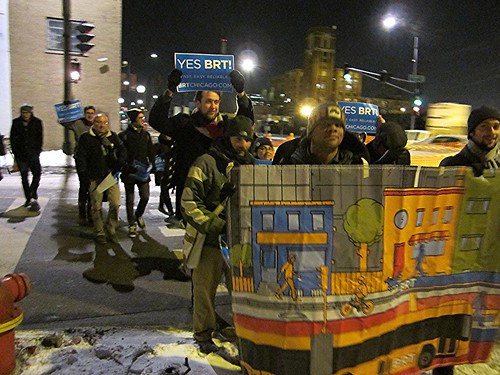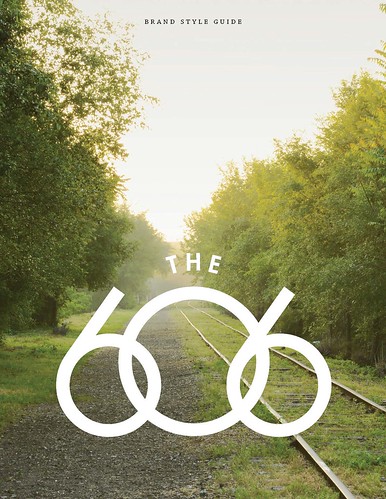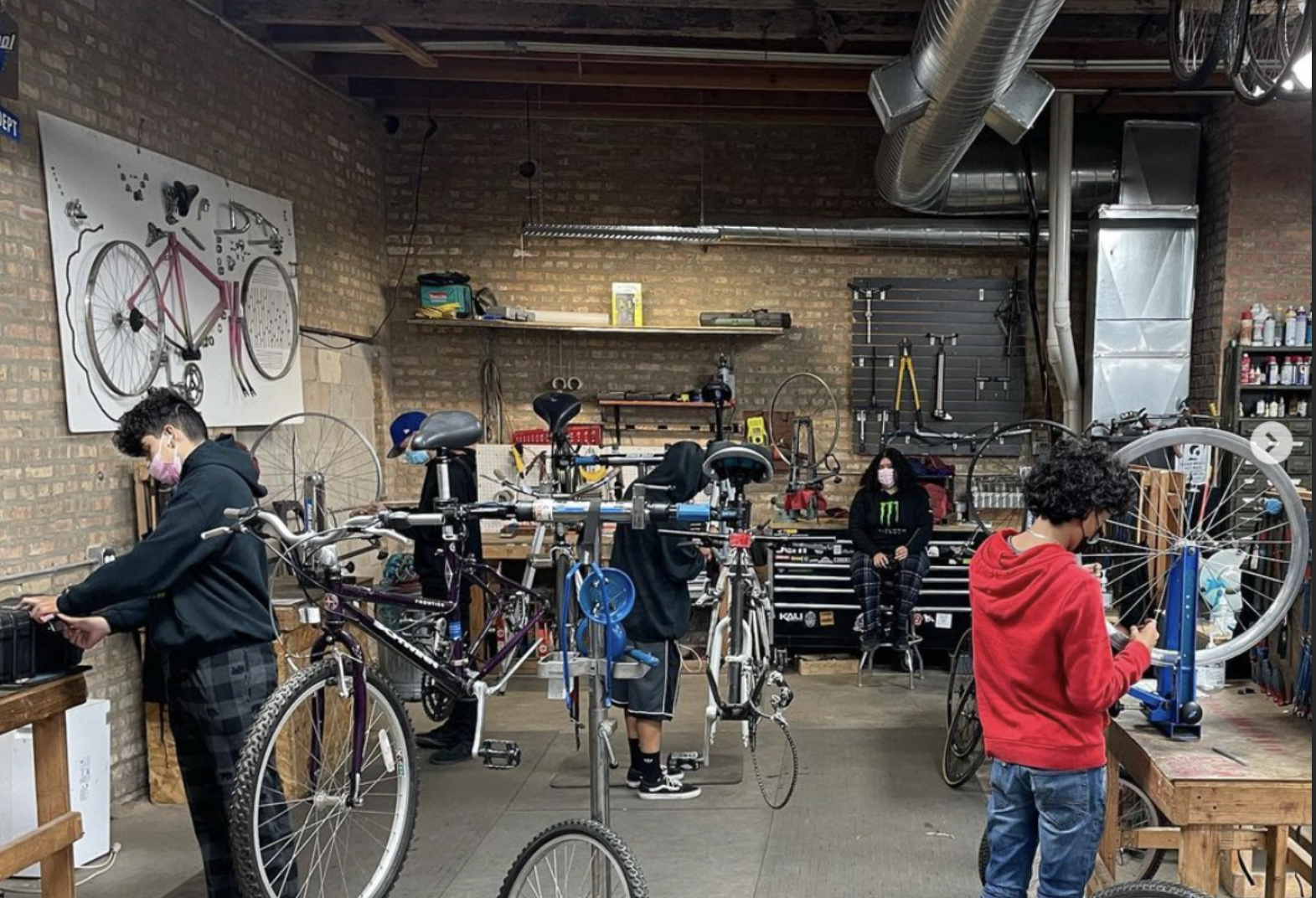The 2013 Chicago Streetsie Awards
9:50 AM CST on December 30, 2013

Season’s Greetings Streetsblog Chicago readers. I hope you’ve had a joyful December and are gearing up for a fabulous New Year’s Eve.
2013 has been a banner year for walking, biking and transit in the Windy City, but there were so many landmarks and firsts, as well as a few discouraging developments, that it’s a bit hard to wrap your head around all the events that took place during our first year of publication. For a recap of some of the key happenings, here are this year's awards, which also ran in Newcity magazine’s Best of Chicago issue. Without further ado, here are the Streetsies…
Best way to squander $2.75 billion and defund public transportation: The Illiana Tollway. On October 17, reps from Metra and Pace shot their own agencies in the foot, casting the deciding yes votes in a Chicago Metropolitan Agency for Planning policy committee decision on whether to move forward with this 47-mile boondoggle. The Illiana would run south of the urbanized Chicago area, serving relatively few motorists and creating only an estimated 940 jobs over the next 40 years, but it would compete with transit for scarce transportation funding. However, Governor Quinn and the Illinois Department of Transportation, which controls the flow of federal dollars to these agencies, pushed hard for the tollway. Metra and Pace caved in to the pressure, which means a darker future for regional transportation.
Best new idea for public transportation: Bus rapid transit on Ashland Avenue. Urban planners from across the country are watching Chicago to see if we can build the nation’s first “gold-standard” BRT corridor. The CTA wants to convert two of the four travel lanes on Ashland to bus-only lanes, with center-running buses stopping every half mile at median stations, creating an ‘L’ train-like experience. Rush hour bus speeds would be nearly doubled to 15.9 mph, which is what’s needed if we want to make transit an attractive alternative. However, the plan faces stiff opposition from residents who are freaked out about the street reconfiguration and the prohibition of most left turns. Who will win the battle of Ashland?
Best CTA success story: The Red Line South reconstruction. When the CTA announced it was shutting down the Red Line from Cermak to 95th for five months to replace 10.2 miles of track, many predicted the $425 million project would cause major headaches for South Siders. However, if the work were only done on weekends it would have cost $75 million more and taken four years. The agency minimized the hassles for riders by providing solid alternative service, including frequent shuttle buses, so that many commutes were actually shorter during the rehab. When the line reopened on October 20, customers were rewarded with a ten-minute-shorter trip from 95th to Roosevelt on silky-smooth rails.
Best thing about the new Divvy bike-sharing system: Watching the Tribune’s Jon Hilkevitch change his tune. When Divvy debuted, the Trib ran a series of articles painting the system as a rip-off, dysfunctional and racist. "Nobody is going to pay $75 -- plus daily overtime fees --- to ride a bike a few times," said William Choslovsky, a random “bicycle-riding lawyer” quoted in a Hilkevitch piece. Less than two months after the launch, Divvy riders had racked up more than 150,000 rides and 458,000 miles, and Hilkevitch ran a column that all but admitted his earlier hatchet pieces were off base, noting that Choslovsky is now a bike-share convert. As Bob Dylan sang, "Don’t criticize what you don’t understand."
Best guess about why the CTA decided to implement the glitchy new Ventra system: They had to. The transit agency says it had no choice because Cubic Transportation Systems, the company that made the Chicago Card, stopped manufacturing magnetic strip cards. The CTA was glad to get out of the banking business by having Cubic take over managing the new Ventra machines. The agency says it stands to save $50 million in operations costs over the next decade. That’s great in theory, but the launch has been rife with snafus, including dozens, or even hundreds, of cards showing up in the mail for a single person. Hopefully, a few months from now these growing pains will be just a memory.
Best new bikeway: The Berteau Greenway. 47th Ward Alderman Ameya Pawar is one of the city’s most progressive politicians on transportation issues, and the only one to endorse the CTA’s bus rapid transit plan. Adding to his street cred is the Berteau Greenway, running a mile between Lincoln and Clark. This bike-priority street allows two-way pedaling on otherwise one-way sections. Car traffic is calmed by bumpouts with landscaping to absorb storm water, a traffic circle and a 20 mph speed limit. The project was watered down somewhat by neighbors who objected to plans to prohibit automobile through traffic, but the greenway is still a shiny new jewel in Chicago’s cycling crown.
Best argument for automated speed enforcement cameras: More than 200 people clocked doing over 60 mph on city streets. Chicago’s speed cam program has been trashed as Big Brother stomping on citizens’ automotive freedom, but numbers don’t lie. On October 11, CDOT announced that nine cameras had issued warnings to more than 200,000 speeders within 40 days. More than 200 involved drivers going over sixty, ten were traveling over 80 mph, and one was driving a terrifying 90 mph. The cams recently started issuing real tickets, with the revenue going towards pedestrian safety and anti-violence programs. Call it a money grab if you like, but if we can discourage speeding, punish lead-foot drivers and fund safety initiatives at the same time, that’s a win-win-win.
Best name for The 606, other than The 606 or the Bloomingdale Trail: The 666. What’s not to like about the Bloomingdale Trail, the 2.75-mile elevated greenway and linear park that promises to put NYC’s High Line to shame? The new name. To avoid confusion with Bloomingdales department store, the city has re-christened the trail plus its access parks as The 606, although the path itself will go by its old appellation. The reboot is a necessary evil for attracting corporate sponsorship, but the planners were asking for trouble by choosing a name that’s so similar to the Number of the Beast. They’re one step ahead of us though – the logo features an extra-large zero, making it difficult to transform into a legible six with the stroke of a Sharpie.
Best feature of the planned Wrigley Field renovations: A proposed 500-car parking garage north of the stadium got kyboshed. The Cubs are lucky to be headquartered in a walkable, bikeable, transit-friendly neighborhood that’s dense with bars and restaurants, and everyone agrees that car traffic is already a nightmare on game days. So why did the team, Alderman Tom Tunney, and some of the neighbors think it might be a good idea to build a massive garage on top of the vast parking lot that sits north of the stadium, a move that would only encourage more people to drive to games, further clogging the streets? Luckily, Eric Hanss launched a petition against the structure that garnered 238 signatures, which helped convince the powers that be to deep-six the proposal. Unfortunately, the city did approve a 493-car parking garage as part of a new mixed-use development just south of the ballfield at the southeast corner of Clark and Addison, despite the fact that this location is a two-minute walk from the Addison Red Line stop.
Most dearly departed Chicago department head: Chicago Department of Transportation Commissioner Gabe Klein. You’d expect something different from a CDOT chief who went to middle school on an ashram with Weezer frontman Rivers Cuomo. After coming here from D.C. with an emphasis on "complete streets" that serve all road users, not just drivers, in just a few years he racked up an impressive list of groundbreaking projects. We now have dozens of miles of protected and buffered bicycle lanes and thousands of Divvy bikes; Bloomingdale Trail construction and the Make Way for People public space program are in progress; and bus rapid transit and the riverwalk extension are on the horizon. While it was a bummer to see him leave town last month to re-enter the private sector, with plans to launch new transportation technology startups, we’ve got our fingers crossed Klein’s successor will be someone just as progressive.
In addition to editing Streetsblog Chicago, John writes about transportation and other topics for additional local publications. A Chicagoan since 1989, he enjoys exploring the city on foot, bike, bus, and 'L' train.
Stay in touch
Sign up for our free newsletter
More from Streetsblog Chicago
It’s electric! New Divvy stations will be able to charge docked e-bikes, scooters when they’re connected to the power grid
The new stations are supposed to be easier to use and more environmentally friendly than old-school stations.
Today’s Headlines for Tuesday, April 23
Communities United: Reports of Bikes N’ Roses’ death have been greatly exaggerated
According to the nonprofit shop's parent organization, BNR has paused its retail component, but is still doing after-school programming and looking for new staff.







